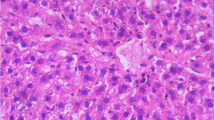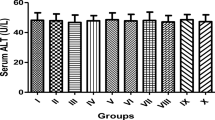Abstract
Tetrapleura tetraptera (TT) and Quassia undulata (QU) are two predominant ethnobotanicals commonly used in traditional medical practices for the management of neurological disorders in Nigeria. However, there is a dearth of information on the toxicological aspects of these plants. Hence, in this study, a 14-day toxicological evaluation of aqueous extracts of TT and QU were carried out in rats. The extracts were administered orally with 5, 50, 500, 2000, and 5000 mg/kg body weight. Signs of toxicity were observed every hour for the first 6 h and every day for 14 days. Mortality, clinical signs, body weight changes, and biochemical parameters were monitored during the study period. There were no mortality or change in weight observed in the rats at all doses for both extracts, while some clinical signs were observed in rats dosed at 5000 mg/kg during the first 2 h of dosing. Also, there were no significant changes in the plasma liver marker enzymes [aspartate aminotransferase (AST), alkaline phosphatase (ALP), and alanine aminotransferase (ALT)], plasma renal marker enzymes [creatinine, urea, blood urea nitrogen (BUN), and uric acid], and the tissue malondialdehyde (MDA) levels of rats administered 5, 50, 500, and 2000 mg/kg of both extracts when compared to the control, but there was a significant increase in the plasma AST, ALT, and MDA levels of rats administered 5000 mg/kg when compared to the control. The no observed adverse effects level (NOAEL) value of 5–2000 mg/kg implies that the extracts could be safe at those doses and could give some information on the safety of these plants with respect to their ethnomedicinal uses especially in the management of neurological disorder.







Similar content being viewed by others
Abbreviations
- TT:
-
Tetrapleura tetraptera
- QU:
-
Quassia undulate
- BWT:
-
Body weight
References
Ademiluyi AO, Oboh G, Ogunsuyi OB, Akinyemi AJ (2012) Attenuation of gentamycin-induced nephrotoxicity in rats by dietary inclusion of ginger (Zingiber officinale) and turmeric (Curcuma longa) rhizomes. Nutr Health 21(4):209–218. https://doi.org/10.1177/0260106013506668
Adesanwo JK, Shode FO, Aiyelaagbe O, Oyede RT, Baijnath H (2009) Isolation and characterization of a new chalcone from the leaves of Heteropyxis natalensis. Int J Med Med Sci 1(2):023–032
Ajaiyeoba EO, Abalogu UI, Krebs HC, Oduola AM (1999) In vivo antimalarial activities of Quassia amara and Quassia undulata plant extracts in mice. J Ethnopharmacol 67(3):321–325. https://doi.org/10.1016/S0378-8741(99)00073-2
Ali BH, Wabel NA, Blunden G (2005) Phytochemical, pharmacological and toxicological aspects of Hibiscus sabdariffa L.: a review. Phytother Res 19(5):369–375. https://doi.org/10.1002/ptr.1628
Atawodi SE-O, Yakubu OE, Liman ML, Iliemene DU (2014) Effect of methanolic extract of Tetrapleura tetraplena (Schum and Thonn) Taub leaves on hyperglycemia and indices of diabetic complications in alloxan-induced diabetic rats. Asian Pac J Trop Biomed 4(4):272–278. https://doi.org/10.12980/APJTB.4.2014C73
Bray GA, Blackburn GL, Ferguson JM, Greenway FL, Jain AK, Mendel CM, Mendels J, Ryan DH, Schwartz SL, Scheinbaum ML, Seaton TB (1999) Sibutramine produces dose-related weight loss. Obes Res 7(2):189–198. https://doi.org/10.1002/j.1550-8528.1999.tb00701.x
Cheng CW, Bian ZX, Wu TX (2009) Systematic review of Chinese herbal medicine for functional constipation. World J Gastroenterol 15(39):4886–4895. https://doi.org/10.3748/wjg.15.4886
Cyril-Olutayo CM, Oladele AT, Elufioye TO (2012) Ethnobotanical survey of plants used as memory enhancer and antiaging in Ondo State, Nigeria. Int J Pharm 2(1):26–32
Daswani GP, Brijesh S, Birdi JT (2006) Preclinical testing of medicinal plants: advantages and approaches. Workshop proceedings on approaches towards evaluation of medicinal plants prior to clinical trial. Organized by the Foundation for medical Research at Yashwantrao Chavan Academy of Development Administration (YASHADA) Pune, India, pp 60–77
Erdem A, Gondogan NU, Usubütün A, Kilinç K, Erdem SR, Kara A, Bozkurt A (2000) The protective effect of taurine against gentamicin-induced acute tubular necrosis in rats. Nephrol Dial Transplantat 15(8):1175–1182
Esterbauer H, Cheeseman KH (1990) Determination of aldehydic lipid peroxidation products: malonaldehyde and 4-hydroxynonenal. Methods Enzymol 186:407–421
Mythilypriya R, Shanthi P, Sachdanandam P (2007) Oral acute and subacute toxicity studies with Kalpaamruthaa, a modified indigenous preparation on rats. J Health Sci 53(4):351–358. https://doi.org/10.1248/jhs.53.351
Oboh G, Ademiluyi AO, Akinyemi A (2012) Inhibition of acetylcholinesterase inhibition activities and some prooxidant induced lipid peroxidation in rat brain by two varieties of ginger (Zingiber officinale). Exp Toxicol Pathol 64(4):315–319.
Ogbonnia S, Adekunle AA, Bosa MK, Enwuru VN (2008) Evaluation of acute and subacute toxicity of Alstonia congensis Engler (Apocynaceae) bark and Xylopia aethiopica (Dunal) A. Rich (Annonaceae) fruits mixtures used in the treatment of diabetes. Afr J Biotechnol 7(6):701–705
Ojewole JA, Adewunmi CO (2004) Anti-inflammatory and hypoglycaemic effects of Tetrapleura tetraptera (Taub) (Fabaceae) fruit aqueous extract in rats. J Ethnopharmacol 95(2-3):177–182. https://doi.org/10.1016/j.jep.2004.06.026
Okolie NP, Falodun A, Davids O (2014) Evaluation of the antioxidant activity of root extract of pepper fruit (Dennetia Tripetala), and it’s potential for the inhibition of lipid peroxidation. Afr J Tradit Complement Altern Med 11(3):221–227. https://doi.org/10.4314/ajtcam.v11i3.31
Otimenyin SO, Olorunfemi PO, Audu OM, Sabo M (2013) Sub-acute toxicity study of herbal blood tonic (hamebuild) in albino rats. Asian J Pharm Clin Res 6(2):78–83
Ozer J, Ratnerb M, Shawc M, Baileya W, Schomaker S (2008) The current state of serum biomarkers of hepatotoxicity. Toxicology 245(3):194–205. https://doi.org/10.1016/j.tox.2007.11.021
Public Health Service (1996) Public Health Service policy on Humane care and use of laboratory animals. U.S. Department of Health and Human Services, Washington, D.C., p 16
Rai V, Mehrotra S (2005) Toxic contaminants in herbal drugs. Environ News, Newsletter of ISEB, India 11 (4)
Ramaiah SK (2011) Preclinical safety assessment: current gaps, challenges, and approaches in identifying translatable biomarkers of drug-induced liver injury. Clin Lab Med 31(1):161–172. https://doi.org/10.1016/j.cll.2010.10.004
Reitman S, Frankel S (1957) A colorimetric method for the determination of serum glutamic oxalacetic and glutamic transaminase. Amer J Clin Pathol 28(1):56–63. https://doi.org/10.1093/ajcp/28.1.56
Rhodes C, Thomas M, Athis J (1993) Principles of testing for acute toxic effects. In: Ballantyne B, Marrs T, Turner P (eds) General and applied toxicology, vol 1. Stockton Press, New York, pp 49–87
Sharp CW, Ottolenghi A, Posner HS (1972) Correlation of paraquat toxicity with tissue concentrations and weight loss of the rat. Toxicol Appl Pharmacol 22(2):241–251. https://doi.org/10.1016/0041-008X(72)90174-3
Stewart MJ, Moar JJ, Steenkamp P, Kokot M (1999) Findings in fatal cases of poisoning attributed to traditional remedies in South Africa. Forensic Sci Int 101(3):177–183. https://doi.org/10.1016/S0379-0738(99)00025-0
Wasan KM, Najafi S, Wong J, Kwong M, Pritchard PH (2001) Assessing plasma lipid levels, body weight and hepatic and renal toxicity following chronic oral administration of a water soluble phytostanol compound FM-VP4 to gerbils. J Pharm Pharm Sci 4(3):228–234
Acknowledgments
We are pleased to acknowledge the management of Adekunle Ajasin University for the release of Year 2014 NEEDS Assessment Fund (AAUA/VC/APU/047) to complete this work and the technical support rendered by Mr. Sunday Idowu Oyeleye and Opeyemi Ogunsuyi.
Funding
This work was funded by Adekunle Ajasin University NEEDS Assessment Fund (AAUA/VC/APU/047).
Author information
Authors and Affiliations
Corresponding author
Ethics declarations
Conflict of interest
The authors declare that they have no conflict of interest.
Ethical approval
All applicable international, national, and/or institutional guidelines for the care and use of animals were followed.
Rights and permissions
About this article
Cite this article
Odubanjo, V.O., Ibukun, E.O. & Oboh, G. Toxicological evaluations of aqueous extracts of two Nigerian ethnobotanicals (Tetrapleura tetraptera and Quassia undulata) of neurological importance in rats. Comp Clin Pathol 27, 441–448 (2018). https://doi.org/10.1007/s00580-017-2611-3
Received:
Accepted:
Published:
Issue Date:
DOI: https://doi.org/10.1007/s00580-017-2611-3




